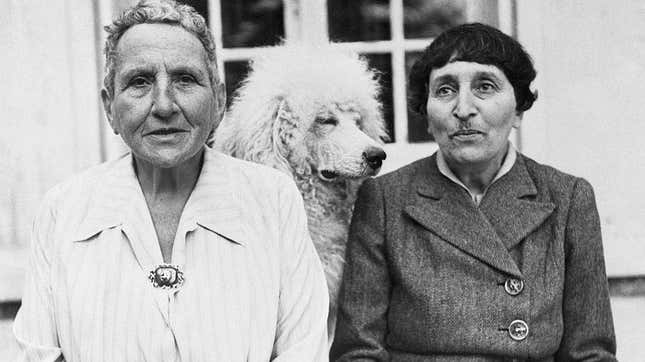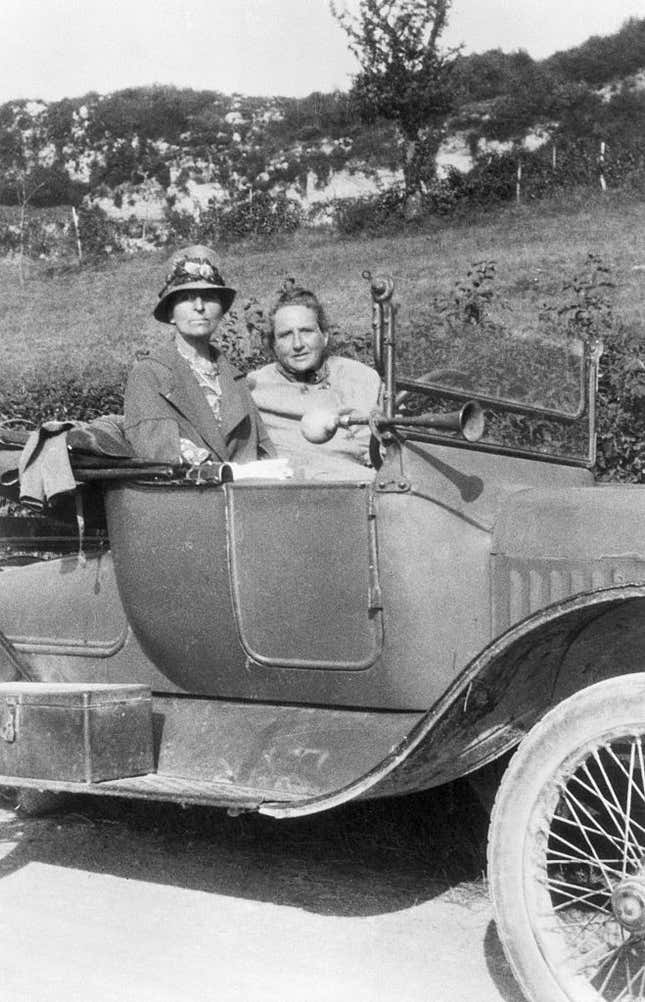
Alice B. Toklas, petite, elegant, and mustachioed, moved to Paris from San Francisco in 1907. The day after she arrived, she met Gertrude Stein, and a bell rang in her head that alerted her that she was in the presence of genius. Did a bell ring in Gertrude Stein’s head to alert her she was in also in the the presence of genius: the future inventor of the pot brownie and, therefore, the Mother of Edibles?
Probably not. For one thing, The Alice B. Toklas Cook Book, which allegedly introduced this recipe to the world, wasn’t published until 1954, eight years after Gertrude Stein’s death. For another, The Alice B. Toklas Cook Book doesn’t actually have a recipe for pot brownies. There is a recipe for Haschich Fudge (unless you happen to be looking at the first American edition; the publisher cut the recipe for legal reasons), but it contains no chocolate. It also wasn’t written by Alice B. Toklas, and it’s unlikely that Alice B. Toklas ever gave it a test run. Did Alice B. Toklas ever even try cannabis? The historical record is silent.
Even though Alice’s claims to genius are shaky, she and Gertrude Stein—who she always referred to in her writing by both her first and last names—had a long and happy and well-fed marriage. This is the true subject of The Alice B. Toklas Cook Book. Alice moved into Gertrude Stein’s apartment on the Rue de Fleurus near the Luxembourg Gardens in 1910, eventually displacing Gertrude’s brother/roommate Leo (who told Gertrude when he moved out with his half of their shared art collection, “I hope that we will all live happily ever after & maintain our respective & due proportions while sucking gleefully our respective oranges”). For the next 36 years, she was the perfect literary wife: she cooked and cleaned (or supervised those who did), typed (and likely edited) Gertrude Stein’s manuscripts, and served as the doorkeeper at their famous Saturday night salon, where she also sat with the wives of geniuses while Gertrude Stein monopolized the geniuses themselves. (Although, as Gertrude Stein noted in The Autobiography of Alice B. Toklas, many of the wives weren’t, technically, wives, and many of the geniuses weren’t geniuses, either. But Alice, equipped with the genius-alert bell in her head, already knew that.)
But The Alice B. Toklas Cook Book only mentions the geniuses in passing, like the time Alice prepared a special dish for Picasso that consisted of striped bass poached in court bouillon and decorated in a modernist style with red mayonnaise, sieved hard boiled eggs, truffles, and chopped fines herbes. (“Picasso exclaimed at its beauty,” Alice reports. “But, said he, should it not have been made in honour of Matisse than of me.”) Mostly, it’s about the adventures of Gertrude Stein and Alice in Paris, the French countryside, and America, sometimes accompanied by their car Aunt Pauline and her successor, Lady Godiva. And it sounds truly delightful to be Gertrude Stein and Alice B. Toklas.
One of their friends once described Gertrude Stein as the irrepressible child in the relationship, while Alice was her minder and the one who, often humorlessly, maintained order in the household. Very little of this dynamic, however, comes through in The Alice B. Toklas Cook Book. Alice describes the women as equal partners, though they each have separate interests and jobs. And Alice herself also had a sense of humor:
Murder and sudden death seem as unnatural [in the kitchen] as they should be anywhere else. They can’t, they can never become acceptable facts. Food is far too pleasant to combine with horror. Al the same, facts, even distasteful facts must be accepted and we shall see how, before any story of cooking begins, crime is inevitable. That is why cooking is not an entirely agreeable pastime. There is to much that must happen in advance of the actual cooking.... It was in those conditions of rationing and shortage [during World War I] that I learned not only to cook seriously but to buy food in a restricted market and not to take too much time in doing it, since there were so many more important and more amusing things to do. It was at this time, then, that murder in the kitchen began.
The chapter goes on to chronicle all the different ways Alice learned to kill dinner.

Later chapters chronicle their adventures transporting supplies during World War I in Aunt Pauline (which, like the French army, Alice joked, only went forward because Gertrude Stein never learned how to shift into reverse); their travels through the French countryside; Gertrude Stein’s book tour of the U.S. after the publication of The Autobiography of Alice B. Toklas, her sole best-seller; and, most touchingly, how they survived World War II in their country house in the Bugey region of southeastern France. The meals you imagine are always more vivid and poignant than the ones you actually eat.
Aside from a few “treasures” from Alice’s childhood in San Francisco in the 1880s, all these recipes were collected during her life in France. Consequently, they are mostly French and mostly old-fashioned, though one, Gigot de la Clinique, was ahead of its time: it called for marinade to be injected into a leg of mutton with a syringe.
The Alice B. Toklas Cook Book was written during a three-month period in 1954 when Alice was laid up with hepatitis. She was, at the time, short of money. Since she and Gertrude Stein were never legally married, she couldn’t inherit Gertrude Stein’s estate; the best Gertrude Stein could do was leave a provision in her will that Alice was at liberty to sell any of the paintings in her collection in their Paris apartment (which, miraculously, had remained intact during World War II; quick-thinking neighbors had scared the Nazis away). Alice was loathe to do this; she said that there was no better way to get to know a work of art than by dusting it every day, and once she knew a painting, she couldn’t bear to sell it. Writing an autobiography was also off the table since, as Alice pointed out to her British publisher, Gertrude Stein had already written her autobiography for her. So a cookbook it was. But the end of the World War II chapter nearly coincided with the end of Alice’s life with Gertrude Stein, who died in 1946 after undergoing surgery for stomach cancer, and there was still quite a few more pages of book to fill. And so Alice called on her friends for contributions.
Which brings us to Haschich Fudge, provided by Brion Gysin, a British-born artist who owned a restaurant in Tangier in the ’50s. The “fudge” is technically a Moroccan sweet called a majoun, a mixture of pulverized fruits, nuts, and spices. Gysin’s special majoun was a favorite of his friends William Burroughs and Paul Bowles, both of whom believed it helped with their writing. Alice later claimed that, under deadline pressure, she hadn’t noticed that the “canibus sativa” in Gysin’s recipe was, in fact, cannabis. Apparently Gysin’s intro, which described it as “the food of Paradise—of Baudelaire’s Artificial Paradise,” slipped past her, too. The Little Old Lady Defense is always useful. (Well, Gysin did say that “it might provide an entertaining refreshment for a Ladies’ Bridge Club or a chapter meeting of the DAR.”)*
*Note: M.F.K. Fisher, who wrote the introduction to the 1984 edition, believed that the wording of Haschich Fudge, like the wording in all the recipes in the “Recipes From Friends” chapter, comes from the friends. “They simply don’t sound Toklas-ian,” she wrote. Still, Alice claimed it later on. You can hear her read it aloud here in this recording on Pacifica Radio from 1963. (Haschich Fudge is the second segment.)
So how did Haschich Fudge morph into pot brownies? For that, we can thank the 1968 movie I Love You, Alice B. Toklas! in which a hippie, played by Leigh Taylor-Young, credits Alice as the inspiration for her “groovy brownies.”
I was tempted to make some Haschich Fudge to taste for myself, but I decided not to for several reasons, chief among them that Gysin’s recipe calls for the raw cannabis to be scattered into the majoun mixture and, well, raw cannabis doesn’t taste very good. A pair of brave journalists from the Globe and Mail in Canada got a Toronto pastry chef to whip up a batch of Haschich Fudge for them; he altered the original recipe by mixing in some cannabutter, which he said would make it much more palatable. The majoun was eaten, some laughs were had, and one of the intrepid reporters said he understood Wolf Blitzer on CNN for the very first time. Magic! (He concludes his report with a touching plea for moderate and civilized edible consumption.)
Reading The Alice B. Toklas Cook Book isn’t quite the same experience as eating an edible (personally, cannabis makes me sleepy), but it is consciousness-expanding in its own way—that is, it gives the reader a chance to enter into the consciousness of a very particular and endearingly peculiar person. Alice herself was dismissive of her work—“as if a cookbook had anything to do with writing,” she concludes her own cookbook—but here I think she is wrong. Maybe she wasn’t a genius like Gertrude Stein, but she could write—a chronicle of good meals eaten over the course of a good life.